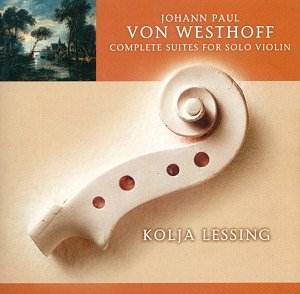The little-known Johann
Paul von Westhoff, Dresden-born, was
a violinist, composer and something
of a prodigious linguist as well. From
his teenage years he was a language
teacher to the princes of Saxony and
later became Professor of Foreign languages
at Wittenberg, though when he died he
was a secretary to the Court of Weimar.
These pioneering sonatas, the first
such complete cycle of solo violin works
before Bach, are constant feasts of
polyphony and sensitively laid out for
the instrument. That they have been
neglected for so long – they were really
only re-encountered (re-discovered sounds
too melodramatic since they had been
known, albeit many dictionaries ignored
them) in the 1970s – is not an index
of their paucity of invention. It would
be objectively true however to say that
judged by the constant expressive demands
of Bach, or the idiosyncratic inventiveness
and technical novelty of Biber, or even
Pisendel’s command, these sonatas occupy
a somewhat lower rung of invention.
They date from 1683
– the date of publication of the six
movement Suite – to 1696, nine years
before Westhoff’s death. He was clearly
a melodist of no little talent; there’s
no meandering or lack of concision.
Since none of the movements breaches
the three minute mark, compression of
musical ideas and linear working out
is the order of the day and the rewards
are plentiful especially in this, the
first recording of the complete sonatas
on disc (though Elizabeth Wallfisch
has recorded II, IV, V and VI for Hyperion).
The influences on the 1683 Suite are
prevailingly French with a Sarabande
that demands good bowing and an accurate
trill – both in evidence here – as well
as the ability to sustain melodic impulse.
In the First of the 1696 set we find
a pleasing component of Westhoff’s compositional
armoury – he was an energetic composer
and wrote correspondingly energetic
Courantes which thrive on motion and
a sense of direction. In some of the
sparer movements, the Sarabande of No.2
for example, Lessing applies some discreet
ornamentation and it’s invariably apposite.
To me this movement is one of the highlights
of the set - intriguingly various and
delightful.
Similarly the Allemande
that opens No.5 (these are incidentally
all four-movement works in classic dance
form; Allemande, Courante, Sarabande
and Gigue) is serious but lyrical with
some rhetorical pauses that are well
judged by Lessing. The final Gigue has
a hunting-like motif that shows some
of the variety the composer imparts.
The opening Allemande of the last Suite
is full of great delicacy and clarity
and the concluding Gigue is vibrant
and vocalised and makes a fine conclusion
to these far too little known works;
those moments when Westhoff departs
from strict form and embraces the rustic
as well as the courtly are invariably
delightful.
The recording derives
from the radio studio in Baden-Baden
and is of excellent quality; not cold
at all. Lessing writes the impressive
notes and has dedicated the recording
to his baby daughter and there’s a delightful
picture of the proud father with her;
let’s hope he’s in at the birth of a
revival of interest in Westhoff as well.
Jonathan Woolf


